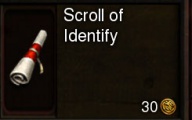Scrolls
Scrolls return in Diablo III, with some key differences.
Diablo II had just two types of scrolls; Identify and Town Portal. Both types could be stored in tomes or books, that held up to 20 of them, for convenience. (It's not known if there are tomes in Diablo III; possibly not, since scrolls stack.)
Diablo III also has just two types of scrolls, being the Identify scroll and the Scroll of Companion, but the Diablo III development team may have some surprises in store for the release of the game.
Contents
Scroll of Identify
Identify Scrolls, which work just as they have in the other games in the series. Magical items (blue items) drop identified, as do white (normal) items, and gray (junk) items. Quest (green) items do not require identification either.
Rare, Legendary, and Set items, however, still must be identified.
An NPC can identify them for you in town (Deckard Cain in D2, and probably in D3 as well, and perhaps the Mystic), or they can be identified anywhere by the use of an identify scroll.
Scroll of Identify now stack up to 20, which saves on inventory space. There also appear to be Books of Identify, though it's not clear why you'd need them when the scrolls stack up anyway?
Scroll of Wealth
Scroll of Wealth was a new type of scroll in Diablo III. Using this scroll allowed you to sell items anywhere, even out in the dungeons. It was meant as a convenience; a way to save the time and trouble of returning to town so often.
It was scrapped from the game, replaces instead by the Cauldron of Jordan which is a quest reward early in the game, and doesn't take up inventory space.
It seems that scrolls do not have a very long lifespan in the development of Diablo games.
Scroll of Town Portal
Town Portals are out of the game entirely. The D3 Team felt they were exploitative and made immersive combat too hard to create. So they're gone; their removal doing much to spur the creation of the Cauldron of Jordan, as well as the salvaging system with the Nephalem Cube and, ultimately, the Stone of Recall. The Stone replaces the functionality of the TP scrolls of yore, while the Cube and the Cauldron negate the need to go back to town in the first place, unless the player is directed so by a quest.
See the Town Portal page for much more about the D3 Team's reasoning on this issue.
Unconfirmed Scrolls
There is the additional possibility of the following scrolls to make it to the final release of the game:
- Scroll of Greed: Shows treasure on map.
The power locked within each treasure of antiquity is far too valuable to squander.
- Scroll of Reforging: This complex arrangement of glyphs and symbols can subtly morph existing enchantments to form a new pattern.
- Scroll of Greater Reforging: This complex array of glyphs and patterns is designed to morph and rearrange existing enchantments.
- Scroll of Superior Reforging: Forging a device of great power is difficult. Disrupting the balance of that power can be dangerous and costly.'
Media
Images of scrolls, as seen in Diablo III, some of which are outdated.
| Items of Diablo III [e] Item Basics Normal Items Crafting Legendary Armor I Legendary Armor II Legendary Weapons 1h Legendary Weapons 2h Item Sets |
|---|



